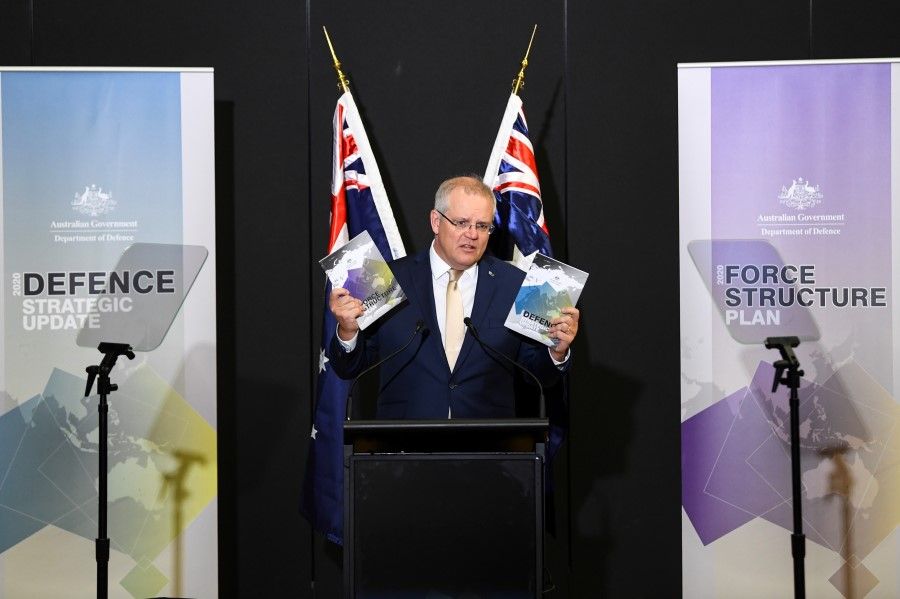Australia boosting security relations with Southeast Asia and the US in the face of heightened threats

On 1 July, Prime Minister Scott Morrison launched the 2020 Defence Strategic Update, Australia's fifth major public defence strategy document in 11 years. The preceding quartet were the 2009 Defence White Paper, the 2013 Defence White Paper, the 2013 National Security Strategy, and the 2016 Defence White Paper. This proliferation of public statements on security strategy is testimony to the deepening strategic angst besetting successive Australian governments, Labor and Liberal National Coalition-led, since the end of the benign post-Cold War interregnum of American unipolarity. We can expect more angst - and as a result, more official documents - in the near future.
Australia's strategic environment is becoming more threatening and more complex, and consequently, Australia will have to spend and do more to defend itself and to be a more useful alliance partner to America.
Despite only being classified as an update to the 2016 Defence White Paper, the 2020 Defence Strategic Update may be the most consequential of the lot for Australia's defence posture towards and defence relations with Southeast Asia. In overall strategic judgement, the Update is very much in line with these earlier documents. Australia's strategic environment is becoming more threatening and more complex, and consequently, Australia will have to spend and do more to defend itself and to be a more useful alliance partner to America. More self-reliance, and more reliance on the alliance relationship with the US is needed.
The 2020 Update commits to not only ring-fence the defence budget increases over the next decade announced in the 2016 Defence White Paper from Covid-19's fiscal damage, but to further extend these increases delinked from GDP growth by four more years. Australia's delayed 2020-21 budget, due for release in early October, will be the first test of this commitment. If the Australian budget upholds the Update with the necessary financial wherewithal, it will be welcome news to many Southeast Asian states (and Japan and India) contemplating or already reducing their own defence outlays due to the pandemic.
Accordingly, the Update stressed that the Australian Defence Force "must be better prepared for the prospect of high-intensity conflict."

The Update includes two important strategic reconsiderations from the 2016 Defence White Paper. First, the document notes that Canberra's security environment is "markedly different from the relatively more benign one of even four years ago, with greater potential for military miscalculation". This could conceivably include state-on-state conflict that could involve the Australian Defence Force (ADF), as and when Australia's interests are threatened. Accordingly, the Update stressed that the ADF "must be better prepared for the prospect of high-intensity conflict". Second, the Update noted that military modernisation in the Indo-Pacific had "accelerated faster than envisaged". Force modernisation across the region's militaries has resulted in the "development and deployment of new weapons that challenge Australia's military capability edge".
This will increase Canberra's interest in deepening security relations with maritime Southeast Asian states and possibly, in bolstering the Five Power Defence Arrangements between Australia, Malaysia, Singapore, New Zealand and the UK.
In response, the 2020 Update gives much greater priority to Australia's immediate region defined as "ranging from the north-eastern Indian Ocean, through maritime and mainland South East Asia to Papua New Guinea and the South West Pacific", and much less to future requests to deploy Australian forces further afield. This will increase Canberra's interest in deepening security relations with maritime Southeast Asian states and possibly, in bolstering the Five Power Defence Arrangements between Australia, Malaysia, Singapore, New Zealand and the UK. The Update states: "Our defence relationships with countries in this region are an essential part of our security planning, including with the Association of Southeast Asian Nations (ASEAN) member states, Papua New Guinea, Timor-Leste and Pacific Island countries."
The Update also gives much greater priority to quickly enhancing Australia's deterrent capabilities and extended its deterrent frontier much further than the traditional focus on the northern approach to Australia through the Indonesian archipelago. The Update notes that "new weapons being introduced into the region have increased range, speed, precision and lethality, placing Australian military forces at greater risk over longer distances".
These (military) capabilities will extend Australia's deterrent shield beyond China's second island chain into the heart of maritime Southeast Asia.

The Air Factsheet addendum to the Update calls for the Royal Australian Air Force to deploy long range anti-ship missiles and in the future hypersonic weapons while increasing the fleet of air-to-air refuelling aircraft. These capabilities will extend Australia's deterrent shield beyond China's second island chain into the heart of maritime Southeast Asia. If delivered, their deployment will give Southeast Asian defence planners more, mostly favourable variables to input into their own planning.
Canberra is asking more of its maritime Southeast Asian security partners, while offering them more in return.
The Maritime Factsheet addendum calls for the development of an undersea surveillance system to detect submarine activity and enhanced maritime mining and countermining capabilities. Australia's new undersea surveillance system and the enhanced intelligence, surveillance and reconnaissance (ISR) assets called for in the Update will provide the ADF with more useful information it can share with Southeast Asian states with weaker domain awareness capabilities.
The 2020 Defence Strategic Update envisions a more forward-leaning Australian defence posture more focussed on maritime Southeast Asia. In essence, Australia is asking of its Southeast Asian partners what Australia is already doing in its alliance with the US. That is, Canberra is asking more of its maritime Southeast Asian security partners, while offering them more in return.
This article was first published as ISEAS commentary 2020/89 "Australia's 2020 Defence Strategic Update: Red Alert, Down Under" by Malcolm Cook.
